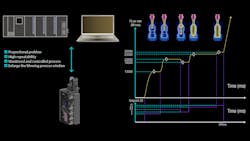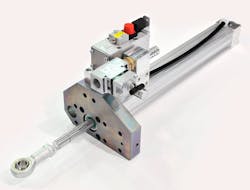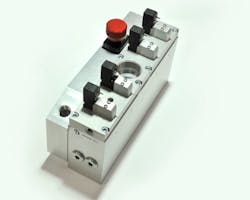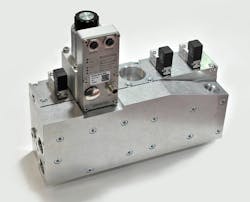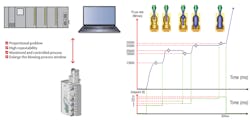Pneumatics in Packaging: New Developments for Better Bottles
Content has been updated as of Oct. 13, 2021
At a Glance:
- Many packaging companies are turning to systems that combine the stretch blow molding (SBM) process with the bottling process in a single production flow.
- Pneumatic technologies can solve PET challenges such as cost, reliability, recyclability and the need for flexible production and IIoT intelligence.
- Smart sensors for SBM machines issue alerts when the leakage rate exceeds a predetermined value, so leaks can be diagnosed early.
Pneumatic technologies and products play a vital role in a wide range of packaging systems serving the consumer products markets. They provide reliable, proven and efficient systems for a wide range of actuation and material movement tasks within many types of packaging systems. The newest generation of smart pneumatics lets them integrate seamlessly into digital packaging machine environments thanks to on-board intelligence and compliance with all relevant communication standards.
The most widely used bottling product in the world is the polyethylene terephthalate (PET) bottle. In 2016, more than 6.12 billion bottles were produced in plants in every major market across the globe. PET bottles are most extensively used for beverages—water, juice and other drinks—but versions of these containers are also used for cosmetics, pharmaceutical, personal care and household chemical products.
The demand for PET bottles remains strong and, as a result, it is estimated that approximately 3,500 stretch blow molding (SBM) systems are built and deployed each year. Several pneumatic technologies play a critical role in these systems, with innovative products such as proportional control valves that help SBM systems provide the flexibility, high throughput rates and product quality that global packaging companies need.
Growth of Combo SBM Production Systems
In SBM machines, PET preforms are mounted on cores and carried through a heating oven to soften them. There is then a pitch change to orient them for insertion into molds that set the shape of the bottles. The preform is physically stretched while low pressure air is injected to instantly expand the bottle (pre-blowing), which conforms to the shape set by the mold and afterwards high-pressure air—up to 40 bar (blowing)—to finalize the production process given the container the final stiffness and start lowering the temperature. The bottles are then ejected for the next step of processing.
Pneumatics plays a key role in these processes: Pneumatic cylinders using low-pressure supply air to manipulate the cores as they move through heating into the stretching and blowing process, while the high-pressure pneumatic valve blocks and control valves deliver the critical expansion blow.
Until recently, manufacturing PET bottles and filling them with beverages were two separate processes, often occurring at two different locations. Many packaging companies—typically drink bottlers—are now purchasing “combo” systems that combine the SBM process with the bottling process in a single, uninterrupted production flow.
It offers great efficiencies for the bottlers and gives them the ability to control and change the size and shape of PET bottles to be more responsive to changing customer trends, market demands and improve product differentiation.
This combo process also helps bottling companies address a concern about sustainability: PET bottles are highly recyclable, but in many markets, recycling programs are not as effective as they could be, leading to efforts to ban or strictly limit PET bottle use. The implementation of combo production systems offers the potential to help significantly reduce the carbon footprint of this container type since they no longer need to be produced in one place and shipped to the bottling plant where they’re then stored till filled.
Key PET Production Challenges
Bottling companies that invest in combo production lines, as well as the original equipment manufacturers (OEMs) supplying their systems, face several challenges related to maximizing the value and performance of their production systems—especially their SBM machines. Among these challenges:
Improving costs and productivity. Typical blow molding production ranges from 2,400 to 3,000 bottles per mold per day. Manufacturers want to sustain that level of production with extremely low rates of rejected/poor-quality bottles.
Demand for wider range of bottle shapes and sizes. Efficient, flexible production of different bottle sizes and shapes is critical to easily produce different sizes and shapes. This is especially important as some companies seek to expand their production of customized bottle shapes and bottle-on-demand capabilities.
Maximum reliability. There is a continued need from bottlers and OEMs for system components with long operating lives and predictive maintenance capabilities.
Industry 4.0/IIoT intelligence. More real-time, usable data from production machines and components within machines that can be used to improve efficiency and reduce machine downtime is needed. Another challenge is to visualize the data and make it actionable—to get the full story on how things are operating.
Recyclability. PET bottlers and end-users are also interested in developing ways to increase the percentage of recycled PET in the production of new containers with the same quality and characteristics.
Multiple pneumatic technologies answer many of these challenges. Many have reliable, high-performance functionality that has been refined through decades of close collaboration with machine builders.
Pneumatics are used in several key areas of SBM machines. Pneumatic air preparation systems provide improved efficiency and better control of both the low-pressure and high-pressure air used by the preform actuators and stretch blow bottle expansion steps.
Low-pressure air activates pneumatic actuators and devices that move and manipulate bottles through the process, such as changing pitch, stretching units and ejection units, while modular filter/regulator units and sensors support the high flow rates needed for the high-pressure bottle expansion step.
The latest generation of smart sensors for this application will issue alerts when the leakage rate exceeds a predetermined value, so leaks can be diagnosed early and addressed before they become a major issue. This gives bottlers actionable insights on machine data (such as flow, pressure and temperature), helping optimize energy consumption, prevent machine downtime and reduce costs.
Another key set of pneumatic components critical to the SBM process are high-performance blowing blocks. These pneumatics provide bottle volume growth control through key parts of the bottle expansion process: pre-blow, blow, recovery and exhaust.
The latest generation of these components is engineered for thousands of hours of operation. Many suppliers have fine-tuned their designs to make them more compact for fitting into tight machine spaces, reducing dead volumes and improving response times to enable high-speed bottle production.
Pneumatic cylinders play an important role in several SBM machine steps, including repositioning the preforms as they move out of the heating oven and are inserted into the blow molds. Pneumatic cylinders, directional control valves, valve systems and custom-designed ejection units are widely used in these applications.
Pneumatics continue to be used in these SBM functions because they are both reliable and efficient systems. Many of these products, such as valves, are hygienically designed for food zone environments. This makes them well-suited for combination plants where the bottles are filled directly down the line from the SBM system.
Intelligent Proportional Control Valves
As with many other automation technologies, pneumatics has been adding capabilities to provide new levels and ranges of control to key manufacturing processes. One major pneumatics supplier has recently introduced a proportional control valve for the pre-blow expansion step in PET production
This control could be a game-changer for this step, replacing what had previously been an on/off high-pressure flow—setting the flow rate and having it remain the same throughout the blow process—with modulation of the flow to fine-tune each bottle’s expansion within the mold.
This new solution combines a specially designed proportional valve, control electronics and software that can either store the set points for the blowing sequence in the valve or respond to control directions from the SBM PLC managing the blowing process.
The bottle expansion typically takes between 70 to 200 ms, depending on the size of the bottle and the desired thickness. In the past, the flow rate would be uniform, but with this proportional valve technology, the bottle growth is intelligently modulated, giving a much greater level of control over how the heated bottle expands within the mold.
This provides real-time control of each machine station, and there can be up to 48 stations. The system also includes the ability to capture feedback results for the quality of each blow, providing critical data needed by bottle manufacturers to fine-tune the process and reduce the number of rejected bottles to a minimum.
Proportional technology for PET blowing moves pneumatics to a whole new level of value for this process, offering multiple advantages:
- The potential to reduce material consumption with the ability to fine-tune bottle wall and shape formation, as well as to create thinner, more lightweight containers
- Enabling the high throughput production of more complex bottle shapes, a critical goal for bottler’s marketing purposes
- Helping to generate energy savings in two ways: by potentially reducing blow air pressure needed to accomplish quality bottle forming and by reducing the heating temperature in the pre-blow oven
- Improving manufacturing flexibility, since the process is easily changed via software/PLC formula specific to each blowing station on the machine
Since the proportional valve system also captures and communicates data about each blow, it provides a rich source of data for quality documentation to safeguard and track process control. It also provides condition monitoring data to support routine and preventive maintenance programs.
Conclusion
In PET blow molding, pneumatics continues to evolve and improve, combining reliable performance for several key process steps with innovations that satisfy the needs of OEMs and manufacturers for greater control and flexibility.
As combo SBM machines continue to be the solution of choice for many bottlers, the need for smart pneumatics that provide IIoT sensors, real-time data capture and interfaces with leading bus architectures will continue to grow.
OEMs who collaborate with experienced pneumatic technology suppliers can take advantage of their expertise in pneumatic technologies as well as co-develop new solutions and refinements to existing products, which ultimately helps improve how pneumatics contributes to the performance and competitive value of their systems.
Gerson Henning is the manager of business development, Food and Beverage Packaging at Emerson.
About the Author
Gerson Henning
Manager of Business Development, Food and Beverage Packaging, Emerson
Gerson Henning is the Manager of Business Development, Food and Beverage Packaging at Emerson where he is responsible to coordinating and developing the company's Food & Beverage business and the application of pneumatic technologies for these applications worldwide.

Leaders relevant to this article:
